
|
We work with our patients so they can achieve and maintain a beautiful smile and healthier gums and teeth. We take the time with our patients to explain their treatment options and inform them of additional preventative care. We feel this will lead to a more trusting doctor/patient relationship and, for many people, relieve the stress about seeing a dentist. We take pride in providing you with a comfortable office experience where our qualified staff is friendly and knowledgeable. Our main office is conveniently located in San Fernando, CA and we invite you to call with any questions or email us via the contact us or request an appointment page of our Web site. We will do everything possible to ensure you a pleasant visit. Insurance and Billing: Our office accepts a variety of different insurance carriers. Please call our office and our staff will help determine your dental benefit as estimated by your insurance carrier. We are currently adding content for this section. In order to be able to keep up with our high standards of service, we need a little more time. Please stop by again. Thank you for your interest! "Please be advised that some of these services might need to be performed by specialized dentists and a referral to these dentists will be needed. Everybody loves a bright white smile, and there are a variety of products and procedures available to help you improve the look of yours. Many people are satisfied with the sparkle they get from brushing twice daily with fluoride-containing toothpaste, cleaning between their teeth once a day and the regular cleanings at your dentist's office. If you decide you would like to go beyond this to make your smile look brighter, you should investigate all of your options. You can take several approaches to whiten your smile:
At your visit we will go over the various approaches.
There's no reason to put up with gaps in your teeth or with teeth that are stained, badly shaped or crooked. Today a veneer placed on top of your teeth can correct nature's mistake or the results of an injury and help you have a beautiful smile. Veneers are thin, custom-made shells crafted of tooth-colored materials designed to cover the front side of teeth. They're made by a dental technician, usually in a dental lab, working from a model provided by your dentist. You should know that this is usually an irreversible process, because it's necessary to remove a small amount of enamel from your teeth to accommodate the shell.
Dentures: If you've lost all of your natural teeth, whether from periodontal disease, tooth decay or injury, complete dentures can replace your missing teeth and your smile. Replacing missing teeth will benefit your appearance and your health. Without support from the denture, facial muscles sag, making a person look older. You'll be able to eat and speak—things that people often take for granted until their natural teeth are lost. There are various types of complete dentures. A conventional full denture is made and placed in the patient's mouth after the remaining teeth are removed and tissues have healed which may take several months. An immediate complete denture is inserted as soon as the remaining teeth are removed. The dentist takes measurements and makes models of the patient's jaws during a preliminary visit. With immediate dentures, the denture wearer does not have to be without teeth during the healing period. Even if you wear full dentures, you still must take good care of your mouth. Brush your gums, tongue and palate every morning with a soft-bristled brush before you insert your dentures to stimulate circulation in your tissues and help remove plaque.
Removable Denture Partial: 
Removable partial dentures usually consist of replacement teeth attached to pink or gum-colored plastic bases, which are connected by metal framework. Removable partial dentures attach to your natural teeth with metal clasps or devices called precision attachments. Precision attachments are generally more aesthetic than metal clasps and they are nearly invisible. Crowns on your natural teeth may improve the fit of a removable partial denture and they are usually required with attachments. Dentures with precision attachments generally cost more than those with metal clasps.
Crowns/Bridges:
If you want a smile that's your crowning glory, you may need a crown to cover a tooth and restore it to its normal shape and size. A crown can make your tooth stronger and improve its appearance.
It can cover and support a tooth with a large filling when there aren't enough teeth left. It can be used to attach a bridge, protect a weak tooth from breaking or restore one that's already broken. A crown is a good way to cover teeth that are discolored or badly shaped. It's also used to cover a dental implant.
Bridges help maintain the shape of your face, as well as alleviating the stress in your bite by replacing missing teeth. Sometimes called a fixed partial denture, a bridge replaces missing teeth with artificial teeth, looks great, and literally bridges the gap where one or more teeth may have been. The restoration can be made from gold, alloys, porcelain or a combination of these materials and is bonded onto surrounding teeth for support. Unlike a removable bridge, which you can take out and clean, a fixed bridge can only be removed by a dentist. An implant bridge attaches artificial teeth directly to the jaw or under the gum tissue. Depending on which type of bridge your dentist recommends, its success depends on its foundation. So it's very important to keep your remaining teeth healthy and strong. Once upon a time, if you had a tooth with a diseased nerve, you'd probably lose that tooth. Today, with a special dental procedure called a root canal therapy you may save that tooth. Inside each tooth is the pulp which provides nutrients and nerves to the tooth, it runs like a thread down through the root. When the pulp is diseased or injured, the pulp tissue dies. If you don't remove it, your tooth gets infected and you could lose it. After the dentist removes the pulp, the root canal is cleaned and sealed off to protect it. Then your dentist places a crown over the tooth to help make it stronger. Most of the time, a root canal is a relatively simple procedure with little or no discomfort involving one to three visits. Best of all, it can save your tooth and your smile! Constant pressure from chewing, grinding or clenching can cause dental fillings, or restorations, to wear away, chip or crack. If the seal between the tooth enamel and the restoration breaks down, food particles and decay-causing bacteria can work their way under the restoration. You then run the risk of developing additional decay in that tooth. Decay that is left untreated can progress to infect the dental pulp and may cause an abscess. If the restoration is large or the recurrent decay is extensive, there may not be enough tooth structure remaining to support a replacement filling. In these cases, we may need to replace the filling with a crown.
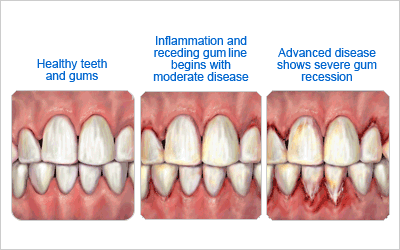
Periodontal disease is an infection of the tissues that support your teeth. Your gum tissue is not attached to the teeth as high as it may seem. There is a very shallow v-shaped crevice called a sulcus between the tooth and gums. Periodontal diseases attack just below the gum line in the sulcus, where they cause the attachment of the tooth and it's supporting tissues to break down. As the tissues are damaged, the sulcus develops into a pocket: generally, the more severe the disease, the greater the depth of the pocket. Periodontal diseases are classified according to the severity of the disease. The two major stages are gingivitis and periodontitis. Gingivitis is a milder and reversible form of periodontal disease that only affects the gums. Gingivitis may lead to more serious, destructive forms of periodontal disease called periodontitis. Some factors increase the risk of developing periodontal disease:
Several warning signs that can signal a problem:
It is possible to have periodontal disease and have no warning signs. That is one reason why regular dental checkups and periodontal examinations are very important. Treatment methods depend upon the type of disease and how far the condition has progressed. Good oral hygiene at home is essential to help keep periodontal disease from becoming more serious or recurring. You don't have to lose teeth to periodontal disease. Brush, clean between your teeth, eat a balanced diet, and schedule regular dental visits for a lifetime of healthy smiles. Crowns and conventional bridges or dentures may not be your only options when replacing missing teeth. For some people, dental implants offer a smile that looks and feels very natural. Surgically placed below the gums over a series of appointments, implants fuse to the jawbone and serve as a base for individual replacement teeth, bridges or a denture.
Candidates for dental implants need to have healthy gums and adequate bone to support the implant. In some cases we will need to graft(add) bone or bone-like material to enhance the area which will receive the implant. Make an appointment with us. We will evaluate the suitability of implants in your specific case based on your needs, your ideals and other relevant factors. You will receive an evaluation by the doctor and a consult with a member of staff about the costs , insurance coverage, methods of payment and financing. No treatment will be started until you get a good chance to understand all the aspects of implant treatment. Implant treatment could be expensive and you will need time to decide or consult your close ones.
Anyone who participates in a sport that carries a significant risk of injury should wear a mouth protector. This includes a wide range of sports like football, hockey, basketball, baseball, gymnastics, and
Mouth protectors, which typically cover the upper teeth, can cushion a blow to the face, minimizing the risk of broken teeth and injuries to the soft tissues of the mouth. If you wear braces or another fixed dental appliance on your lower jaw, your dentist may suggest a mouth protector for these teeth as well. Accidents can happen during any physical activity. A mouth protector can help cushion a blow to the face that otherwise might result in an injury to the mouth. A misdirected elbow in a one-on-one basketball game or a spill off a bicycle can leave you with chipped or broken teeth, nerve damage to a tooth or even tooth loss. A mouth protector can limit the risk of such injuries as well as protect the soft tissues of your tongue, lips and cheek lining. A properly fitted mouth protector will stay in place while you are wearing it, making it easy for you to talk and breathe. An orthodontic problem is called a malocclusion, meaning "bad bite." Some examples of causes of malocclusion are crowded teeth, extra teeth, missing teeth or jaws that are out of alignment. Most malocclusions are inherited, although some can be acquired. Acquired malocclusions can be caused by accidents, early or late loss of baby teeth, or sucking of the thumb or fingers for a prolonged period of time. Children and adults can both benefit from orthodontics. It is recommended that every child receive an orthodontic evaluation by age seven. Treatment may take a little longer for adults. Because an adult's facial bones are no longer growing, certain corrections may not be accomplished with braces alone. The average treatment time is about 24 months and varies with individual patients. Usually, adult treatment takes a little longer than a child's treatment. |



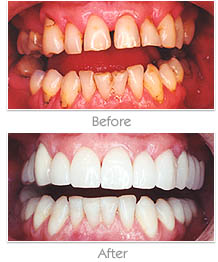
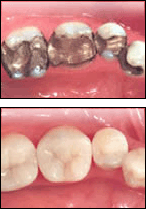
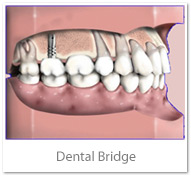 If you're missing one or more teeth, you may notice a difference in chewing and speaking. There are options to help restore your smile.
If you're missing one or more teeth, you may notice a difference in chewing and speaking. There are options to help restore your smile.
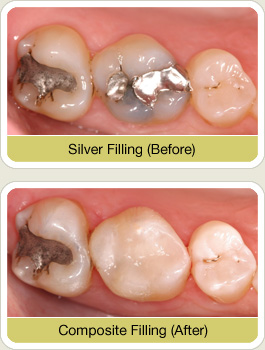
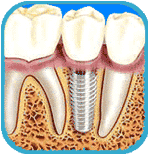
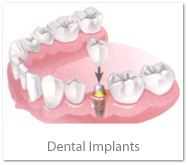 Implants offer stability because they fuse to your bone. Integration of the implants into your jaw also helps your replacement teeth feel more natural and some people also find the secure fit more comfortable than conventional substitutes.
Implants offer stability because they fuse to your bone. Integration of the implants into your jaw also helps your replacement teeth feel more natural and some people also find the secure fit more comfortable than conventional substitutes.
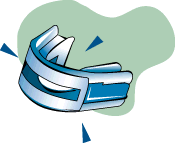 volleyball.
volleyball.